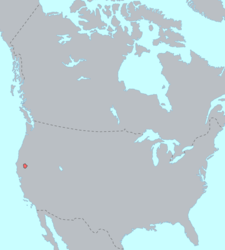| This article includes a list of general references, but it lacks sufficient corresponding inline citations. Please help to improve this article by introducing more precise citations. (August 2024) (Learn how and when to remove this message) |
Ethnic group
| Regions with significant populations | |
|---|---|
| Languages | |
| English, formerly Yana | |
| Related ethnic groups | |
| Yahi |

The Yana are a group of Native Americans indigenous to Northern California in the central Sierra Nevada, on the western side of the range. Their lands, prior to encroachment by white settlers, bordered the Pit and Feather rivers. They were nearly destroyed during the California genocide in the latter half of the 19th century. Descendants of the Central and Southern Yana continue to live in California as members of Redding Rancheria.
Etymology
The Yana-speaking people comprise four groups: the North Yana, the Central Yana, the Southern Yana, and the Yahi, two of which - the Central and Southern - have living descendants. The noun stem Ya- means "person"; the noun suffix is -na in the northern Yana dialects and -hi in the southern dialects.
History
Further information: Population of Native CaliforniaAnthropologist Alfred L. Kroeber put the 1770 population of the Yana at 1,500, and Sherburne F. Cook estimated their numbers at 1,900 and 1,850. Other estimates of the total Yana population before the Gold Rush exceed 3,000. They lived on wild game, salmon, fruit, acorns and roots.
Their territory was approximately 2,400 square miles, or more than 6,000 km, and contained mountain streams, gorges, boulder-strewn hills, and lush meadows. Each group had relatively distinct boundaries, dialects and customs.
Yahi
The Yahi were the southernmost portion of the Yana. They were hunter-gatherers who lived in small egalitarian bands without centralized political authority, were reclusive and fiercely defended their territory of mountain canyons. The Yahi initially numbered around 400.
The Yahi were the first Yana group to suffer from the Californian Gold Rush, as their lands were the closest to the gold fields. They suffered great population losses from the loss of their traditional food supplies and fought with the settlers over territory. They lacked firearms, and armed white settlers committed genocide against them in multiple raids. These raids took place as part of the California Genocide, during which the U.S. Army and vigilante militias carried out killings as well as the relocation of thousands of indigenous peoples in California. The massacre reduced the Yahi, who were already suffering from starvation, to a population of less than 100.
On August 6, 1865, seventeen settlers raided a Yahi village at dawn. In 1866, more Yahis were massacred when they were caught by surprise in a ravine. Circa 1867, 33 Yahis were killed after being tracked to a cave north of Mill Creek. Circa 1871, four cowboys trapped and killed about 30 Yahis in Kingsley cave.
Ishi
Main article: Ishi
The last known survivor of the Yahi was named Ishi by American anthropologists. Ishi had spent most of his life hiding with his tribe members in the Sierra wilderness, emerging at the age of about 49, after the deaths of his mother and remaining relatives. He was the only Yahi known to Americans. Ishi emerged from the mountains near Oroville, California, on August 29, 1911, having lived his entire life outside of the settler-colonial culture.
Ishi would teach Saxton T. Pope archery as referenced in Pope's book on archery by the last Yana Indian. He died in 1916.
See also
Notes
- Redding Rancheria (2013). With the Strength of Our Ancestors (film). United States. Retrieved September 27, 2013.
- Kroeber, p.883
- Cook, 1976a:177, 1976b:16
- Pritzker, Barry M. (2000). A Native American Encyclopedia: History, Culture, and Peoples, p. 156. Oxford University Press.
- "Ishi's Hiding Place", Butte County Archived July 16, 2006, at the Wayback Machine, A History of American Indians in California: HISTORIC SITES, National Park Service, 2004, accessed November 5, 2010
- ^ "We Are California: The Yana/Yahi People". California Humanities. Retrieved November 16, 2014.
- ^ Diamond, Jared (1997), Guns, Germs, and Steel, New York: W. W. Norton & Company, p. 374, ISBN 0-393-31755-2
- Robert K. Hitchcock, and Charles Flowerday. “Ishi and the California Indian Genocide as Developmental Mass Violence.” Humboldt Journal of Social Relations, no. 42, Department of Sociology, Humboldt State University, 2020, pp. 69–85.
- Kroeber, Karl; Kroeber, Clifton B. (January 2003). Ishi in Three Centuries. U of Nebraska Press. p. 377. ISBN 0-8032-2757-4.
- Pope, Saxton T. (Saxton Temple) (May 1, 2005). Hunting with the Bow & Arrow.
References
- Cook, Sherburne F. 1976a. The Conflict Between the California Indian and White Civilization. University of California Press, Berkeley.
- Cook, Sherburne F. 1976b. The Population of the California Indians, 1769–1970. University of California Press, Berkeley.
- Heizer, Robert F., and Theodora Kroeber (editors). 1979. Ishi the Last Yahi: A Documentary History. University of California Press, Berkeley.
- Johnson, Jerald Jay. 1978. "Yana" in Handbook of North American Indians, vol. 8 (California), pp. 361–369. Robert F. Heizer, ed. (William C. Sturtevant, general ed.) Washington, D.C.: Smithsonian Institution. ISBN 0-16-004578-9/ISBN 0160045754.
- Kroeber, A. L. 1925. Handbook of the Indians of California. Bureau of American Ethnology Bulletin No. 78. Washington, D.C.
- Kroeber, Theodora. 1961. Ishi in Two Worlds: A Biography of the Last Wild Indian in North America. University of California Press, Berkeley.
- Sapir, Edward (1910). "Yana Texts", University of California Publications in American Archaeology and Ethnology, vol. 1, no. 9. Berkeley: University Press.
External links
- Ishi: The Last Yahi (1992), documentary, IMDB
- , Overland Monthly Journal, 1875, online at University of Michigan
- Map: "Native Tribes, Groups, Language Families, and Dialects of California region in 1770", California Prehistory
|